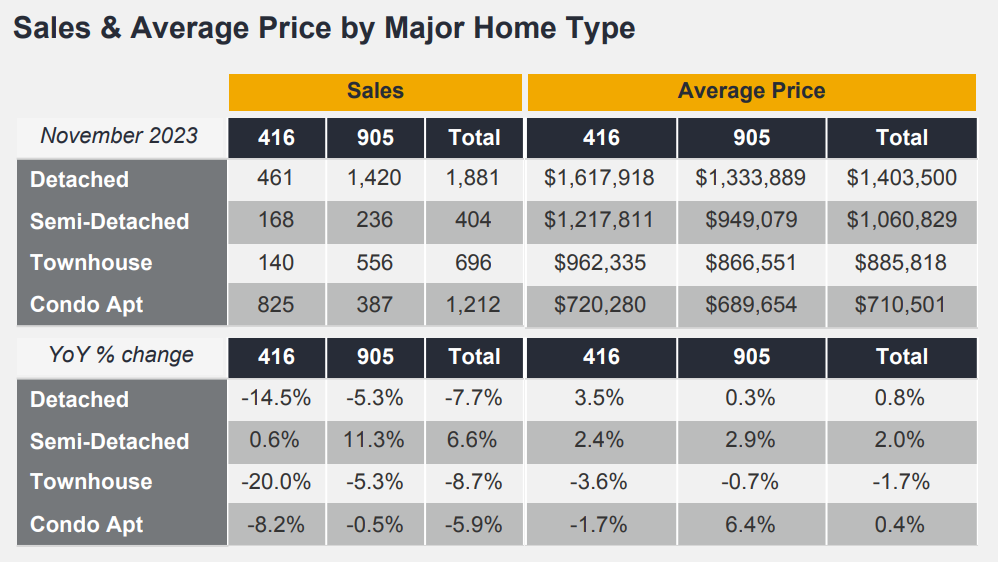In a classic dance of economics, when demand outstrips supply, prices soar. Conversely, do prices plummet when shelves are stocked high but buyers are few? In this issue of The Property Manual, let’s explore these questions within the bustling Real Estate Market in the Greater Toronto Area (GTA).
The latest figures from TRREB for November reveal a fascinating narrative: 4,236 properties exchanged hands. Listings saw an uptick of 16.5% compared to last year during this month; however, active listings dwindled from 13,019 in October to just 11,911 in November—a notable supply contraction of 5.5%. Detached houses dominated sales at an impressive rate of 44.4%, with more than four hundred homes sold, with most within the $1 million to $1.249 million bracket.

Despite this surge in listing availability—defying expectations—the selling price remained unchanged year-over-year. The average home price dropped slightly from October’s $1,125,928 to $1,082,179 in November. Yet, it still stands robustly above January’s figures amidst biting inflation and soaring borrowing costs that have tested affordability like never before.
Reflecting on 2021’s record-breaking pace reveals that Year-To-Date (YTD) transactions until November reached an astonishing high at 115,716 compared to YTD Nov 2023, which stood at 62,575. However, as interest rates climbed steeply—from a mere 0.25 % to 5% —transaction volumes have significantly cooled off.
Now armed with these statistics, let us ponder GTA market resilience despite such headwinds. The answer lies beneath layers of economic forces at play.
Immigration is surging, setting new records, while housing shortages intensify, exacerbating the Ontario Housing Crisis, which paradoxically props up property values even amid escalating affordability concerns due to persistent strong demand.
Ontario grapples with a daunting challenge: bridging a vast chasm between current housing supplies versus the ambitious goal set forth by the Ford government aiming to construct 15 million new homes over the next decade. Yet 20 municipalities teeter dangerously close to missing their construction benchmarks for 2023 —a misstep potentially derailing the entire ten-year plan.
Cities failing to meet targets risk forfeiting access to part of Ontario’s 12 billion infrastructure fund earmarked to bolster local growth initiatives—a financial blow could hamper municipal capabilities to provide essential services or keep pace with the burgeoning demands population growth brings alongside it.
A critical bottleneck thwarting progress is the phenomenon of stalled developments—projects greenlit yet not commenced, leading to frustration among city officials who feel handcuffed by the post-approval process. Mississauga exemplifies the predicament of sitting on a backlog of 29,000 approved units unbuilt while its citizens navigate through limited options with sky-high pricing, prompting calls for action pressure developers at both the governmental level and public outcry.
Amidst growing clamour to address delays predominantly attributed to private sector players in the real estate realm, the provincial government hesitates to impose punitive actions against developers, favouring a collaborative approach to align public goals and increase housing stock while respecting private interests in the development cycle.
Ford administration remains steadfast in ensuring infrastructure readiness so developers ready to break ground face no obstacles while steering clear of penalizing those facing legitimate challenges ranging from financing issues to market volatility cost escalations tied directly to construction activities.
If developing conditions aren’t deemed profitable enough, we’re left staring down the barrel, continued supply shortage perpetuating upward pressure, keeping property prices aloft.
While Bank Canada signals its intention to maintain the policy rate steady throughout the rest of 2023, the underlying issue of insufficient inventory continues to fuel the flames of the affordability crisis, sidelining potential buyers.
On a brighter note, there is a glimmer of hope horizon inflationary trends show signs of easing. The Consumer Price Index CPI fell to 3.1 % in October, though still hovering above the Bank’s 2% target. Interest rate swap markets buzz cautious optimism predicting a 60% chance of seeing cuts possibly in March coming year, albeit some economists caution that might not see fruition until later mid-next year.
Banks face a delicate balancing act: confidence grows efficacy monetary policies combatting inflation. They must also navigate cautiously to avoid rekindling those pressures or causing a sharp decline in bond yields and housing market activity.
In conclusion, the Toronto real estate market demonstrates remarkable resilience in economic headwinds. While supply constraints and high demand drive prices, cautious optimism is on the horizon with potential shifts in interest rates and inflationary pressures. As we navigate these complex times, buyers, sellers, and industry professionals must stay informed and adaptable. The interplay between market forces will undoubtedly shape the landscape of Toronto’s housing sector in 2024 and beyond—making it an ever-evolving narrative that demands our attention and strategic foresight.
Photo by Scott Graham on Unsplash

